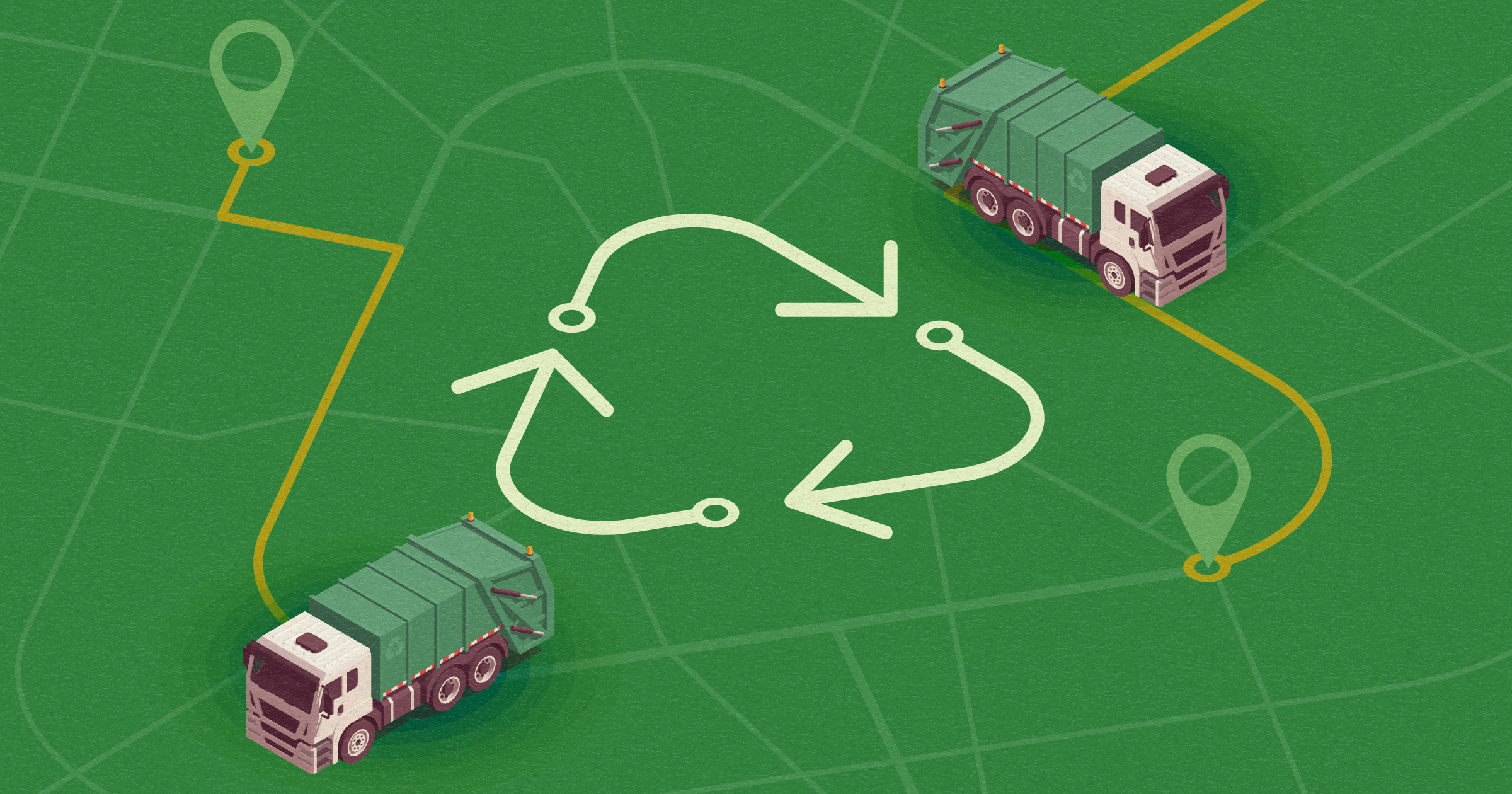When Waste Management Companies Pick Up AI Tools
Waste management companies are addressing safety, efficiency, and maintenance challenges with artificial intelligence technologies.
News
- Gulf Nations Fast-Track AI Ambitions, UAE Leads Regional Readiness, says BCG Report
- AI Professionals form a Redefined Workforce. But Systemic Roadblocks Persist, Survey Finds
- AI-Driven Scams Surge as Microsoft Blocks $4 Billion in Fraud Attempts
- Identity-based Attacks Account for 60% of Leading Cyber Threats, Report Finds
- CERN and Pure Storage Partner to Power Data Innovation in High-Energy Physics
- CyberArk Launches New Machine Identity Security Platform to Protect Cloud Workloads

Carolyn Geason-Beissel/MIT SMR | Getty Images
A Waste Connections garbage truck driver was making his rounds in a quiet neighborhood. He got out of his front-loading truck, picked up a few trash barrels, emptied them into the truck, and put them back in place before getting into his truck for the next stop. The same routine continued house after house, community after community.
He wrapped up his work at an apartment complex and needed to back up the truck. As he was climbing into the driver’s seat, his eye seemed to catch some slight movement in the rearview mirror. With nothing visible in his line of sight, he dismissed it as a trick of the light and prepared to drive off.
However, he had a nagging feeling that something was amiss. Acting on intuition, he got out of the truck and walked to the back of it to inspect. What he saw sent a chill down his spine.
A small girl was hiding quietly between the huge truck’s rear tires. While the driver was still in a state of shock, she hushed him to stay quiet. The girl whispered that she was playing hide-and-seek with her friends and didn’t want the driver to give away her location.
Thanks to the alert driver’s instinct, a disaster was narrowly averted, and the driver had a story to tell that quickly spread within the company.
I heard this anecdote narrated by Eric Hansen, CIO of Waste Connections, in a panel discussion at the recent WasteExpo. Such high-risk safety incidents are not uncommon in the industry; unfortunately, many don’t have such a happy ending.
Few people give a second thought to the garbage trucks that rumble through neighborhoods week after week, collecting our refuse. But behind the scenes, waste management companies face complex hurdles, including safety concerns, routing challenges, and maintenance failures.
The use of artificial intelligence tools designed to help companies shape a smoother and more efficient waste collection process offers an informative study on how AI can adjust safety and cost equations in certain industries. Let’s examine how AI is changing the waste management industry, drawing from real-world examples and industry statistics.
The Role of AI in Enhancing Fleet Safety
Hansen’s story underscores the broader issue of fleet safety in waste management. Accidents involving garbage trucks are a key concern. Drivers often operate for long hours each day, performing manual, repetitive, and tedious tasks, making them susceptible to fatigue-related impairments. Such impairments lead to slower reaction times, decreased awareness, and, ultimately, a higher likelihood of accidents.
The Federal Motor Carrier Safety Administration estimates that fatigue causes up to 40% of accidents for all types of trucking. This translates to over 100,000 motor accidents in the U.S., 71,000 injuries, and 800 deaths. The financial implications are staggering, with an estimated annual cost of $20 billion and reputational damage for companies.
Tenvos AI uses machine learning to identify signs of driver impairment caused by fatigue. For example, a sleep-deprived driver could exhibit subtle changes in their voice, facial expressions, and behavior. While these minor variations might be difficult to detect manually, AI can identify thousands of behavioral features.
By studying patterns across multiple drivers, the tool gains insights into the various factors that affect fatigue and determines the strongest indicators of impairment. “Our technology uses multimodal signals to detect impairment caused by fatigue, alcohol, or cannabis intoxication,” said Rima Seiilova-Olson, founder and CEO at Tenvos AI.
Its technology kicks in before the driver takes the wheel. Companies can proactively screen drivers when they report for duty by analyzing video of their appearance and voice at the time of check-in. Tenvos AI then uses drivers’ mobile phones to monitor them while they are in transit. By flagging risks and making personalized recommendations, the AI tool aims to help prevent disasters through data-driven interventions.
Some waste management companies also seek to provide real-time feedback and coaching to drivers via AI tools. For example, Netradyne’s Driver-i system uses computer vision-based AI algorithms to monitor driver behavior in real time. This in-cab technology includes a dual-pane panoramic device utilizing two cameras, one focused on the road and the other on the driver.
The road-facing camera uses AI to track objects like pedestrians, vehicles, and road signs to determine safe driving practices. The driver-facing camera employs AI to watch out for drowsiness or distractions, such as phone usage, and prompts the driver to take corrective actions.
Later, drivers can periodically review their driving through virtual coaching based on video footage and performance tracking. The system also provides company managers with an analytics-driven overview of all drivers within a fleet, enabling safety teams to identify patterns, driving habits, and areas for improvement.
Leaders will have to address people’s privacy concerns about being filmed continuously at work, while companies seek to reduce distracted driving, improve regulatory compliance, and reduce accidents (and related insurance claims).
When AI Meets Routing Efficiency
The U.S. Department of Energy reports that roughly 136,000 refuse vehicles are driving on U.S. roads every day. With an average of more than 1,000 daily stops, trash vehicles have a mean fuel economy of 2.8 miles per gallon, which translates to over 1.2 billion gallons of annual fuel consumption.
Real-time variables like traffic, weather, and ad hoc customer requests lead to inefficiencies, wasted fuel, and missed pickups. “In waste collection, about 80% of the route stays the same, while 20% could evolve due to factors such as customers going on a vacation or opting out of service,” Hansen said.
In a recent survey, transportation and logistics leaders said they believe AI solutions will have the biggest impact on route optimization, compared with other fleet management benefits. AI-powered route optimization tools can suggest the most efficient routes based on current traffic conditions, accidents, road closures, weather, and other factors.
Additionally, AI systems help accommodate last-minute customer requests by integrating them into the route plan. They start by analyzing historical route data to understand typical patterns and challenges. The systems then incorporate real-time inputs, such as current traffic or weather alerts, to refine the route plan on the fly. This continuous feedback loop allows the system to suggest detours, optimize fuel usage, and better meet customer needs without causing disruptions — and ideally helps waste management companies boost overall customer satisfaction and miss fewer pickups.
Intelligent route optimization software makers say the technology can reduce planning and administration time by 25% to 75% and cut carbon dioxide emissions by up to 25%. Savings in those areas would add up, given what the waste management industry spends on fuel each year. For example, Republic Services, an industry leader, spent $541 million on fuel in 2023, or 3.6% of its revenue. If we extrapolate using a similar assumption of 3.6% of $140 billion overall industry revenue, the fuel spending is in the range of $5 billion.
Addressing Unplanned Breakdowns With AI
The truck components with the most unscheduled repairs are those involving cooling, brakes, lighting, wheels, and tires. AI tools change the dynamics in this area by analyzing data from sensors embedded in multiple truck components and provide real-time data on their condition.
AI algorithms can predict potential failures and maintenance needs, allowing proactive measures to be taken before a breakdown. Roadside repairs cost approximately four times more than in-shop repairs. By integrating proactive maintenance into a fleet’s operational plan, a shift to proactive maintenance should extend the lifespan of trucks and enhance overall fleet efficiency.
One example of an AI tool addressing maintenance woes is Intangles’ AI-powered predictive fleet maintenance system for refuse trucks. It uses AI and digital twin technology to create virtual replicas of each vehicle that are continuously fed with historical and real-time data from various sensors and subsystems, such as the engine, battery, and air intake system. Able to closely monitor the vehicle’s health, the solution predicts potential issues like engine faults, coolant leaks, or battery degradation.
Upon detecting potential issues, the tool alerts operators to the severity of the detected problem and suggests corrective actions. The platform can then direct vehicles to nearby service facilities and access a database of 16,000 diagnostic fault codes and repair strategies, making the repair process less prone to guesswork.
The Future of AI in Waste Management
The transportation industry is abuzz about advancements in self-driving vehicles, particularly long-haul trucking, where vehicles travel thousands of miles across varying terrains. However, the waste management industry presents a unique set of challenges.
This logistics setup involves conducting high-touch operations within residential areas, navigating narrow streets, and managing various types of waste, such as recyclables, compostables, and hazardous materials. Additionally, much of the infrastructure in this industry needs upgrading, making implementing fully autonomous vehicles a more complex and time-consuming endeavor. Thus, despite the excitement around autonomous vehicles, it will take time for them to become a reality in waste management.
Until then, tools that augment intelligence, or that treat AI as a copilot, can help companies looking to improve driver safety, optimize routes, and predict maintenance needs.





